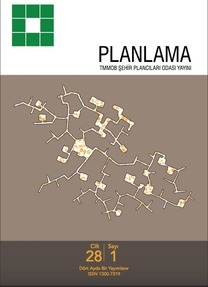Soylulaştırmanın Güncel Dinamiklerinin Bir Analizi: Serinyol/Antakya Örneğinde "Öğrencileştirme" Süreci ve Etkileri
Analysis of the Current Dynamics of Gentrification: "Studentification" Process and its Impact in Serinyol/Antakya Case
___
- Allinson, J. (2006). Over-Educated, Over-Exuberant and Over Here? The Impact of Students on Cities. Planning, Practice & Research, 21(1), 79-94.
- Bridge, G. (2001). Estate Agents as Interpreters of Economic and Cultural Capital: The Gentrification Premium in the Sydney Housing Market. International Journal of Urban and Regional Research, 25(1), 87-101.
- Butler, T., Lees, L. (2006). Super-Gentrification in Barnsbury, London: Globalization and Gentrifying Global Elites at the Neighbourhood Level. Transactions of the Institute of British Geographers, 31(4), 467-487.
- Chatterton, P. (1999). University Students and City Centres –The Formation Of Exclusive Geographies: The Case of Bristol, UK. Geoforum, 30(2), 117-133.
- Cloke, P., Thrift, N. (1990). Class Change and Conflict in Rural Areas: Global Processes and Their Responses. T. Marsden, L. Philip, & W. Sarah (Ed.), Rural Restructuring, içinde (s.165-181). Londra: David Fulton Publishers.
- Davidson, M., Lees, L. (2005). New-Build ‘Gentrification’ and London's Riverside Renaissance. Environment and Planning A, 37(7), 1165-1190.
- Glass, R. (1964). London: Aspects of Change. Londra: MacGibbon & Kee.
- Google Earth. (2020). https://www.google.com/earth/ Erişim Tarihi: 03.07.2020
- Gotham, K. F. (2005). Tourism Gentrification: The Case of New Orleans' Vieux Carre (French Quarter). Urban Studies, 42(7), 1099-1121.
- Hamnett, C. (2000). Gentrification, Postindustrialism, and Industrial and Occupational Restructuring in Global Cities. G. Bridge & S. Watson (Ed.), A Companion to the City, içinde (s. 331-341). Oxford: Blackwell.
- Harvey, D. (2014). Seventeen Contradictions and The End of Capitalism. Oxford: Oxford University Press.
- He, S. (2015). Consuming Urban Living in ‘Villages in the City’: Studentification in Guangzhou, China. Urban Studies, 52(15), 2849-2873.
- Hubbard, P. (2009). Geographies of Studentification and Purpose-Built Student Accommodation: Leading Separate Lives?. Environment and Planning A, 41(8), 1903-1923.
- Lees, L. (2003). Super-Gentrification: The Case of Brooklyn Heights, New York City. Urban Studies, 40(12), 2487-2509.
- Lees, L., Slater, T., Wyly, E. (2008). Gentrification. Londra: Routledge
- Ley, D. (1996). The New Middle Class and The Remaking of The Central City, Oxford: Oxford University Press.
- Munro, M., Turok, I., Livingston, M. (2009). Students in Cities: A Preliminary Analysis of Their Patterns and Effects. Environment and Planning A, 41(8), 1805-1825.
- Rugg, J., Rhodes, D., Jones, A. (2002). Studying a Niche Market: UK Students and the Private Rented Sector. Housing Studies, 17(2), 289-303.
- Sassen, S. (1991). The Global City: New York, London and Tokyo. New York: Princeton University Press.
- Savage, M., Warde, A. (1993). Urban Sociology, Capitalism and Modernity. Hampshire: Macmillan International Higher Education
- Smith D.P. (2002). Patterns and Processes of ‘Studentification’ in Leeds. Regional Reviews, 11, 17–19.
- Smith, D. P. (2005). Studentification: The Gentrification Factory. R. Atkinson & G. Bridge (Ed.), Gentrification in a Global Context içinde (s. 72-89). Londra: Routledge.
- Smith, D. P., Phillips, D. A. (2001). Socio-Cultural Representations of Greentrified Pennine Rurality. Journal of Rural Studies, 17(4), 457-469.
- Smith, N. (2002). New Globalism, New Urbanism: Gentrification as Global Urban Strategy. Antipode, 34(3), 427-450.
- Taş, B., Türkan, O. (2016). Üniversite Öğrencileri İkametgah Durumu ve Şehir İlişkileri: Çankırı Örneği. Journal of International Social Research, 9(47), 403-410.
- Tuncer, T., İslam, T. (2017). Yeni Bir Soylulaştırma Formu Olarak Öğrencileştirme (Studentification): Bosna-Hersek Mahallesi’nde (Konya) Değişen Mahalle İçi Dinamikler. Planlama Dergisi, 27(3), 303-313.
- T.C. Gençlik ve Spor Bakanlığı Kredi ve Yurtlar Genel Müdürlüğü Yükseköğrenim Kredi ve Yurtlar Kurumu. (2020). KYK Hatay İl Müdürlüğüne Bağlı Yurtlara Ait Bilgiler. http://www.mku.edu.tr/files/1351- 4451e580-5ac8-4e00-99e6-fb8a90377065.pdf Erişim Tarihi 30.07.2020
- TÜİK. (2020). Adrese Dayalı Nüfus Sayımı Verileri. Türkiye İstatistik Kurumu. Ankara.
- Urry, J. (1995). A Middle-Class Countryside. M. Savage & B. Tim (Ed.), Social Change and the Middle Classes içinde (s. 205-219). Londra: UCL Press.
- Yılmaz, C. (2011). Anadolu Kentlerinin Öğrencileşmesi: Başka Bir Kentleşme Deneyimi. Sosyoloji Dergisi 25, 1-17.
- YÖK. (2020). Yükseköğretim Kurulu Başkanlığı Yükseköğretim Bilgi Yönetim Sistemi Verileri. https://istatistik.yok.gov.tr/ Erişim Tarihi 30.07.2020
- ISSN: 1300-7319
- Yayın Aralığı: 3
- Başlangıç: 1986
- Yayıncı: TMMOB Şehir Plancıları Odası
Türkiye'de Kentsel Dönüşümün Yasalar ve Aktörler Üzerinden Dönemsel Olarak Değerlendirilmesi
Kuşak Değişimi Bağlamında Kentsel Kamusal Mekânı Yeniden Düşünmek
Çevresel Dönüm Noktaları ile Ekosistem Hizmetleri ve Ekonomik Kökenleri
Türkiye’deki Serbest Planlama Bürolarının Coğrafyası: Mekansal ve Sektörel Analiz
Müştereklerin Çitlenmesi Ekseninde Kadınlar: Ekofeminist Perspektiften Türkiye’de Çevre Hareketleri
Açık Yeşil Alan Sistemi Planlanma ve Tasarım Süreçlerinde Millet Bahçelerinin Rolü
Farklı Sokak Kanyonlarında Rüzgârın Hava Kirliliği Dağılımı Üzerindeki Etkisi: Erzurum Örneği
